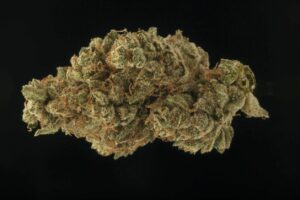Traumatic brain injuries (TBI) affect around two million Americans every year. And of those, nearly 50,000 of are fatal. A number of varied events can cause brain injuries, like accidents, sports injuries or stroke.
But a 2014 study published in the journal American Surgeon uncovers that people with tetrahydrocannabinol (THC) in their systems have a far lower rate of death from a TBI than those who don’t have THC in their bodies.
FOLLOW US ON FACEBOOK & INSTAGRAM
The reason? Research on the neuroprotective properties of cannabis suggests that THC, along with other cannabinoids, can activate an array of different processes that help heal damaged tissues and encourage the growth of new neural networks in the brain.
This is because these potent cannabinoids appear to activate self-protective procedures in the brain that help it heal from various traumatic events.
What’s a Traumatic Brain Injury & How Do You Get One?
Just about everyone has had a bump on the head. Most of the time, these kinds of events don’t cause serious damage, thanks to the hard skull that protects the vulnerable, gelatinous brain.
But the skull can’t always protect the brain, and sometimes it even contributes to the damage. TBIs can range from relatively minor to severe and even fatal. Common causes of TBI include:
- Impact injuries: These types of injuries can include open or closed injuries to the head. But whether they open the skull, these injuries can cause damage to brain tissues and bleeding in the brain.
These kinds of injuries come from events like falls, car accidents, assault and high-impact sports like football. Even getting hit in the head by a ball can cause an impact brain injury. Soldiers in combat areas also experience these types of injuries, often more than once.
- Diffuse axonal injuries: Also called deceleration injuries, this kind of trauma happens when the skull is moving and suddenly stops, such as in a car accident.
This causes the brain to keep moving against the skull, creating a phenomenon known as diffuse axonal shearing—the compressing and stretching of delicate neuronal axons.
-
Hypoxia: This is a condition in which the brain is deprived of oxygen for a period of time. Causes of hypoxia include respiratory failure, heart attacks and drowning. When the brain doesn’t receive oxygen, brain cells begin to die.
-
Metabolic disorders: When someone exposes their brain cells to chemicals or toxins that can damage neurons, metabolic disorders occur. Whether ingested, inhaled or placed on the skin, certain solvents, insecticides and other poisons can cause the death of brain cells and neuronal connections, too.
With other kinds of physical trauma, the greatest damage occurs at the time of the event, and after that, the body gradually begins to heal.
But when an impact injury, axonal injury or an event like a stroke harms the brain, most of the damage actually happens after the event, during the recovery period.
And this is where cannabis can help.
How the Brain Can Damage Itself After Injury
In the minutes, days and weeks after trauma to the brain, the body responds to the injury with a flood of chemicals. It also initiates accelerated processes that contribute to the death of cells and disruption of neural connections, including:
-
Increased glutamate production: Glutamate is a brain chemical that plays a key role in brain signaling and information processing. It’s also one of the most abundant neurotransmitters in the central nervous system. But in large amounts it can also be toxic to neurons. A brain injury causes the release of massive amounts of glutamate, which can kill cells in the affected areas.
-
Brain inflammation: Inflammation is a normal response to trauma as the brain works to repair itself. But inflammation can also affect the way neural networks operate and can interfere with the communication between cells.
-
Increased oxidation from free radicals: When oxygen molecules in the body destabilize, toxic byproducts called free radicals form. These chemicals can damage cell DNA and even cause cell death through a process called oxidation. A healthy system can neutralize free radicals before they can do much harm. But after an injury, levels of free radicals can soar. This causes severe oxidative stress, which damages brain cells.
How THC & Other Cannabinoids Can Protect an Injured Brain
THC is the best known of the many cannabinoids in the Cannabis sativa plant. Favored by many as a way to feel a pleasant, relaxing high, THC also has a complicated relationship with the brain.
Some studies have shown that heavy cannabis consumption can damage brain cells and can cause long-term deficits in memory and concentration, especially in young consumers.
And THC can also cause anxiety and paranoia, rather than euphoria, under some circumstances. But THC’s affinity for endocannabinoid receptors in the brain appears to make it uniquely able to help the brain repair itself after an injury.
The endocannabinoid system (ECS) is a widespread network of receptors throughout the body that responds both to cannabinoid-like chemicals that the body produces, and to cannabinoids from outside sources, mainly cannabis.
So far, research has identified two cannabinoid receptors: CB1 and CB2.
Both of these receptors are plentiful in the brain, and THC directly activates them. This means that THC can affect the role of these receptors in processes that accelerate after a brain injury.
The CB1 receptor affects the production of glutamate, which floods the brain after an injury. Research shows that THC can reduce the amount of glutamate that’s released, so that it has less power to damage and even kill brain cells.
THC also works together with cannabidiol (CBD) and other cannabis compounds to reduce inflammation and help protect the body from the harmful effects of free radicals after a brain injury.
Research shows that cannabis is a powerful neuroprotectant that can guard brain cells and neural networks even in diseases like Alzheimer’s and head trauma from sports injuries.
And THC just may be the cannabis compound that can save lives and help the brain heal itself after injury.
Photo credit: StunningArt/Shutterstock.com
If you’re new to cannabis and want to learn more, take a look at our Cannabis 101 index of articles. And if you have questions about cannabis, ask them and our community will answer.






